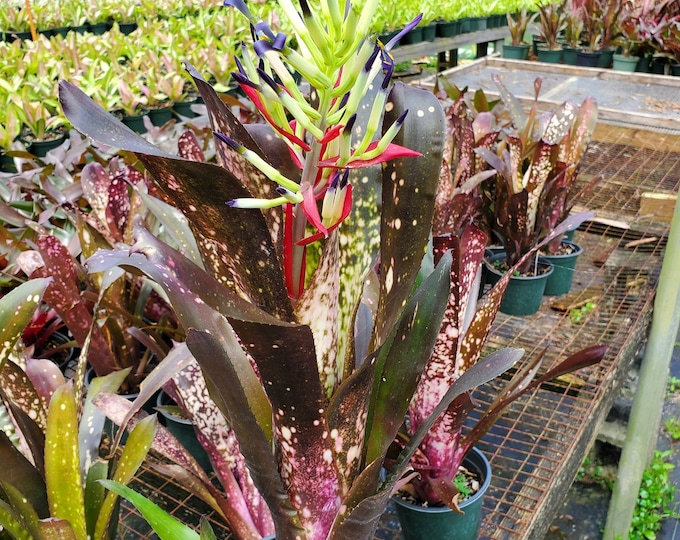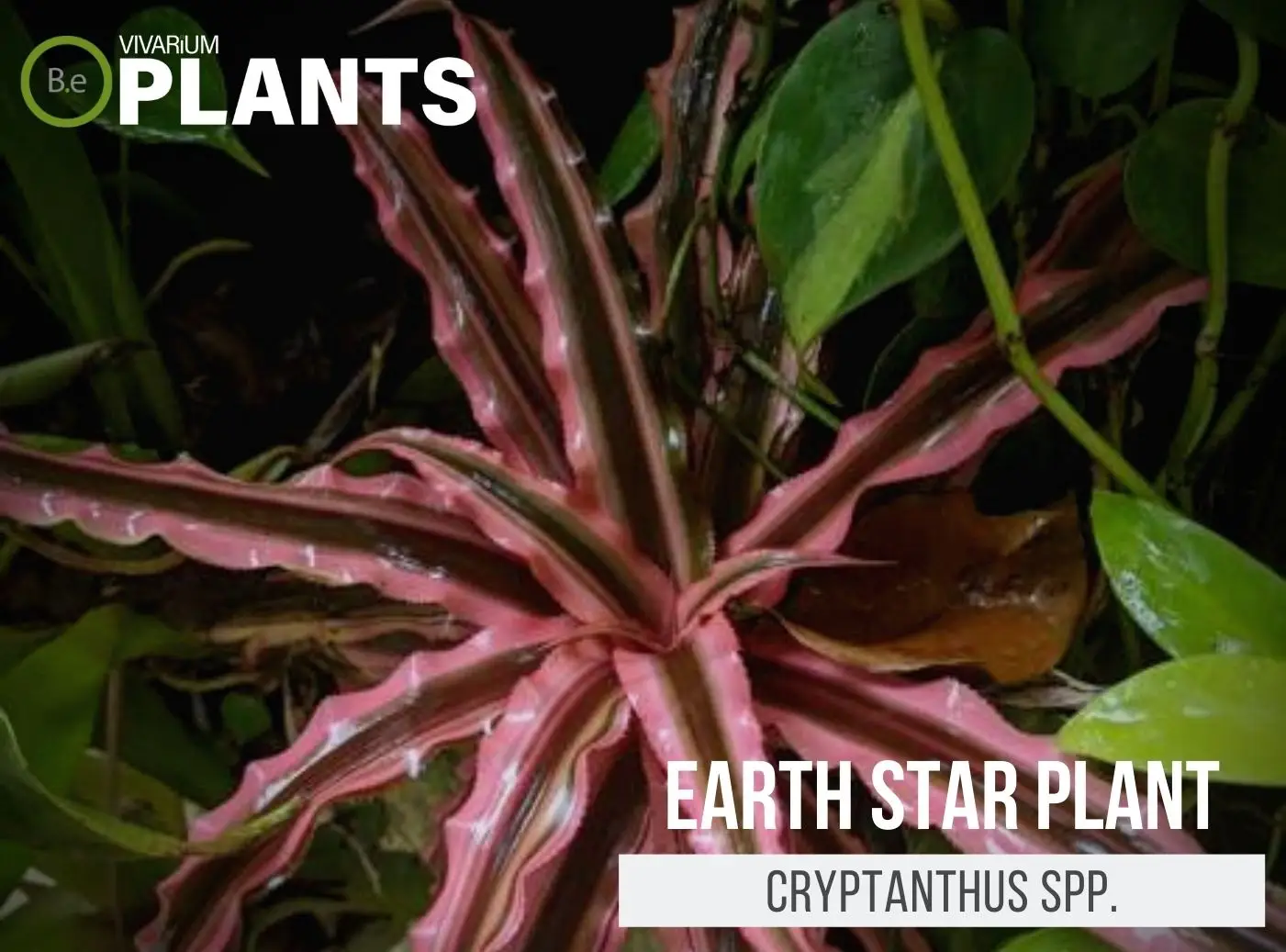Billbergia spp. (Queen’s Tears) is a natural wonder to witness!
Notorious for its sun-catching, bell-shaped bracts, and vibrant foliage, Queen’s Tears boasts a striking appearance.
This air plant is extremely easy to care for and widely used in vivariums.
Queen’s Tears can survive in low humidity, making it a great choice for many other environments as well.
This beautiful bromeliad is sure to add an exotic touch to any setup!
Table Of Contents:
ToggleWhat are Queen’s Tears?
Queen‘s Tears is a Bromeliad species, originating from the forests of Brazil and Paraguay.
It is an epiphyte known for its large, red/orange bracts and its glossy, deep green leaves.
The bracts form a beautiful cup–like shape when blooming, which attracts hummingbirds, butterflies, and other pollinators.


Queen’s Tears Facts
Queen’s Tears will almost never bloom indoors but its colorful bracts make it an attractive species for plastic–free vivariums.
It is also a great houseplant due to its easy–care profile and does not need a lot of water or pruning for it to thrive.
One downside is that this species will easily outgrow small terrariums and may need to be repotted or divided from time to time.
Description
Queen’s Tears has dense foliage and vibrant bracts.
It has wide leaves with colors ranging from green to deep purple.
It also grows flower spikes in bright red, orange, and yellow colors.
The bracts are trumpet–shaped and may be up to 18 inches long.
The plant can be used as a ground cover or a climbing species.
It is also fast–growing and low maintenance in comparison to many other bromeliads.
Habitat
Queen’s Tears originates from the warm and humid regions of Brazil and Paraguay.
It thrives in tropical climates with temperatures ranging from 65–77°F.
It does not need a lot of water or direct sunlight and does better with diffused light for protection from the hot sun.
pH Preference
Queen‘s Tears prefers acidic soil to thrive. The preferred pH range is from 5.5 to 7.0, with an ideal range of 6.0–6.5.
If the soil is too acidic, it can cause burning and browning of the leaves and stunted growth.
The plant requires regular testing of the soil to ensure the ideal pH range is maintained.
Vivarium Type
The billbergia bromeliad is quite an easy-going species.
With that in mind, it will not be too complicated when it comes to choosing the type of enclosure it is grown in.
It is best to try and replicate the plant’s natural habitat as much as possible.
Doing so will make it easier to provide this bromeliad with its basic needs.
The proper setup and theme of the enclosure will make a big difference to the overall look and health of the plant.
Be sure to choose setups that are moist and high in humidity.
Here are recommended vivariums it will do well in:
- Paludariums – Half aquatic/ half terrain-based enclosure.
- Terrariums – Fully terrain-based enclosures with little to no aquatic features.
Vivarium Placement
Queen‘s Tears is an excellent addition to any vivarium setup.
It is an easy–care plant and its vibrant colors can give a beautiful pop to any tank.
It prefers diffused sunlight, so placing it near a light fixture or a window can provide the ideal lighting needs.
It can also be suspended with strings or strung on driftwood to provide a cascading effect.
Substrate
Queen‘s Tears needs a shredded bark or peat moss/coco soil mix–based substrate.
It thrives best in well–draining and slightly acidic substrates.
Additionally, providing support to the plant (i.e. driftwood or rocks) is important to keep the plant upright and in place.
Lighting
Queen‘s Tears does not need direct sunlight, but it does need at least 12 hours of light each day.
This is especially important for the growth of the plant and the production of colorful bracts.
If it is placed in a vivarium with other live animals, a high–powered LED terrarium light would be ideal as it produces very little heat and does not disturb the animals.
Buy Queen’s Tears
When it comes to buying rainbow plants, there are a few things to keep in mind.
Making sure the plant is healthy when purchased is essential for its success in a vivarium.
Vegetation that is already in poor conditions will have a very hard time adjusting to new environments.
Always make sure to buy from a reliable and honest establishment.
Click the image below to find out more about the current price and other relative info about this plant.
Queen’s Tears Care and Propagation
Queen‘s Tears is fairly easy to care for, with few requirements.
It needs to be watered zealously during its active growth period but should be kept on the drier side during the resting period.
To propagate, division of the mother plant is required.
The pups should be gently separated from the mother, then re–potted in their own pot with a suitable substrate and fertilized.
How to Grow
Queen‘s Tears can be propagated by division or by replanting offsets.
When propagating by division, new plants should be separated from the mother plant with a sharp and sterile knife, and each division should have some roots and some foliage.
When replanting offsets, simply remove the offset from the mother plant and pot in a substrate.
Both methods work but the division is the preferred method.
Watering
Queen‘s Tears requires regular watering during its growing season and should be almost completely dried out when the plant is not actively growing.
Wetting the substrate a few times a week is enough to keep the plant hydrated and healthy.
Over–watering can lead to root rot and fungus, so it is important to know when to water and when not to water.
Plants Similar to Queen’s Tears
Adding diversity to an enclosure is key to an aesthetically pleasing setup.
Try mixing up the look of your vivarium with different flora that can easily co-exist in the same types of environment.
Furthermore, if for some reason you find the rainbow plant is hard to acquire or would like to consider something similar to this plant…
Here are other terrarium plants you might find will do well with or in the place of Billbergia spp.:
Conclusion
In conclusion, Billbergia spp. is an ideal plant for any vivarium due to its hardiness and ease of care.
It offers unique colors and sizes, making it the perfect accent plant that can be used in many terrariums.
With the right care and a little patience, Billbergia bromeliad can become the perfect centerpiece in any vivarium!
Frequently Asked Questions
Yes, Queen’s Tears can be an excellent indoor plant. It is native to Brazil and is easy to care for because it does not require direct sunlight or frequent watering. It is an excellent houseplant choice for any room in the home or terrarium, as it adds a unique look to the environment.
Queen’s Tears usually bloom several times a year, with the flowers lasting anywhere from one week to two months.
Yes, Queen‘s tears can be planted in the ground in warm climates where they will receive plenty of indirect sunlight. In colder climates, they can be grown in a pot indoors or in a terrarium.
Billbergia spp. are nicknamed “Queen‘s tears“ because they produce tears of a resin–like sap when they are in bloom and look like a queen‘s tears running down her face.






